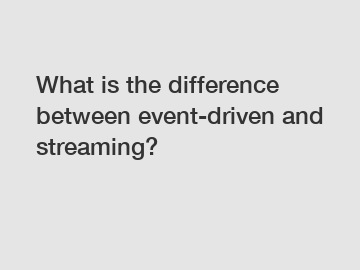What is the difference between event-driven and streaming?
In today's rapidly evolving technology landscape, two terms that are frequently mentioned when discussing real-time data processing are "event-driven" and "streaming". Often used interchangeably, these concepts possess unique characteristics that set them apart. In this article, we delve into the subtle yet significant differences between event-driven and streaming architectures. By clarifying these distinctions, we aim to provide a comprehensive understanding of both approaches, enhancing trustworthiness in the technological realm.
Defining Event-Driven Architecture:
At its core, event-driven architecture (EDA) is a design pattern where the flow of an application is primarily driven by events. Events are occurrences triggered by changes in a system, such as a user interacting with an application or an IoT device detecting an anomaly. These events are captured, processed, and disseminated to the interested parties, enabling timely and contextual actions.

In EDA, events act as first-class citizens, meaning they are the central component around which systems are built. This paradigm emphasizes loose coupling, extensibility, and scalability. Developers focus on decoupling event producers and consumers to ensure system components function independently, promoting flexibility and adaptability.
Understanding Streaming Architecture:
On the other hand, streaming architecture revolves around the notion of continuous data flow in real-time. Streaming systems enable the processing of large volumes of data in motion, delivering insights and actions at scale. The key aspect of streaming is dealing with infinite datasets, processing them incrementally as they arrive, rather than analyzing them retrospectively.
Streaming platforms, like Apache Kafka and Apache Flink, form the backbone of a streaming architecture. These systems effectively handle data ingestion, processing, and output, making it feasible to process high-volume, time-sensitive information. Streaming pipelines consist of data sources, processing components, and data sinks, enabling real-time decisions based on data flowing continuously.
Comparing the Differences:
The essential difference between event-driven architecture and streaming lies in their fundamental purposes. EDA emphasizes event-centricity, focusing on reacting to individual events and building systems around them. In contrast, streaming is more concerned with data flow, analyzing and acting on continuous streams rather than individual events.
EDA, with its event-centricity, blends well with traditional request-driven systems, enabling responsiveness to specific events. It excels in scenarios where event handling, sequencing, and contextual actions are crucial, such as IoT sensor networks, event logging, and financial transactions. By processing events as they occur, EDA offers near-instantaneous insights and decision-making capabilities.
On the other side, streaming architecture shines in scenarios where large-scale data processing and analyzing unbounded datasets are paramount. Use cases like real-time analytics, fraud detection, and monitoring complex systems benefit greatly from streaming's ability to provide insights based on active data streams. Streaming excels at capturing, processing, and acting upon continuous and evolving information, assuring operational efficiency and agility.
Event-Driven Streaming: A Harmonious Synergy:
While event-driven architecture and streaming have distinct purposes, they are not mutually exclusive. In fact, both can coexist harmoniously in modern data processing systems. Event-driven systems can generate events, which are then ingested into streams for real-time processing. Streaming platforms handle the voluminous data flow, ensuring scalability and fault tolerance.
This synergy empowers organizations to capture the value of individual events by processing them in real-time while benefitting from a continuous data stream. The combination enables real-time and contextual decision-making, as well as long-term analysis using historical data.
Conclusion:
In a data-driven world, understanding the differences between event-driven and streaming architectures is essential. Event-driven architecture focuses on individual events, allowing for responsiveness and near-real-time actions, whereas streaming architecture processes continuous data flows, enabling large-scale processing of infinite datasets.
While event-driven architecture emphasizes event-centricity, streaming architecture is designed to handle massive volumes of real-time data. However, both approaches can complement each other, providing organizations with the best of both worlds.
Having a solid grasp of these distinctions fosters trustworthiness in adopting and implementing the right architecture for specific use cases. By leveraging the strengths of event-driven and streaming paradigms, organizations can propel themselves into a future where real-time insights and data processing hold the key to success.
If you are looking for more details, kindly visit Event Streaming Platform Vs Message Queue, slack billing, Event Streaming Platform Vs Message Queue.


